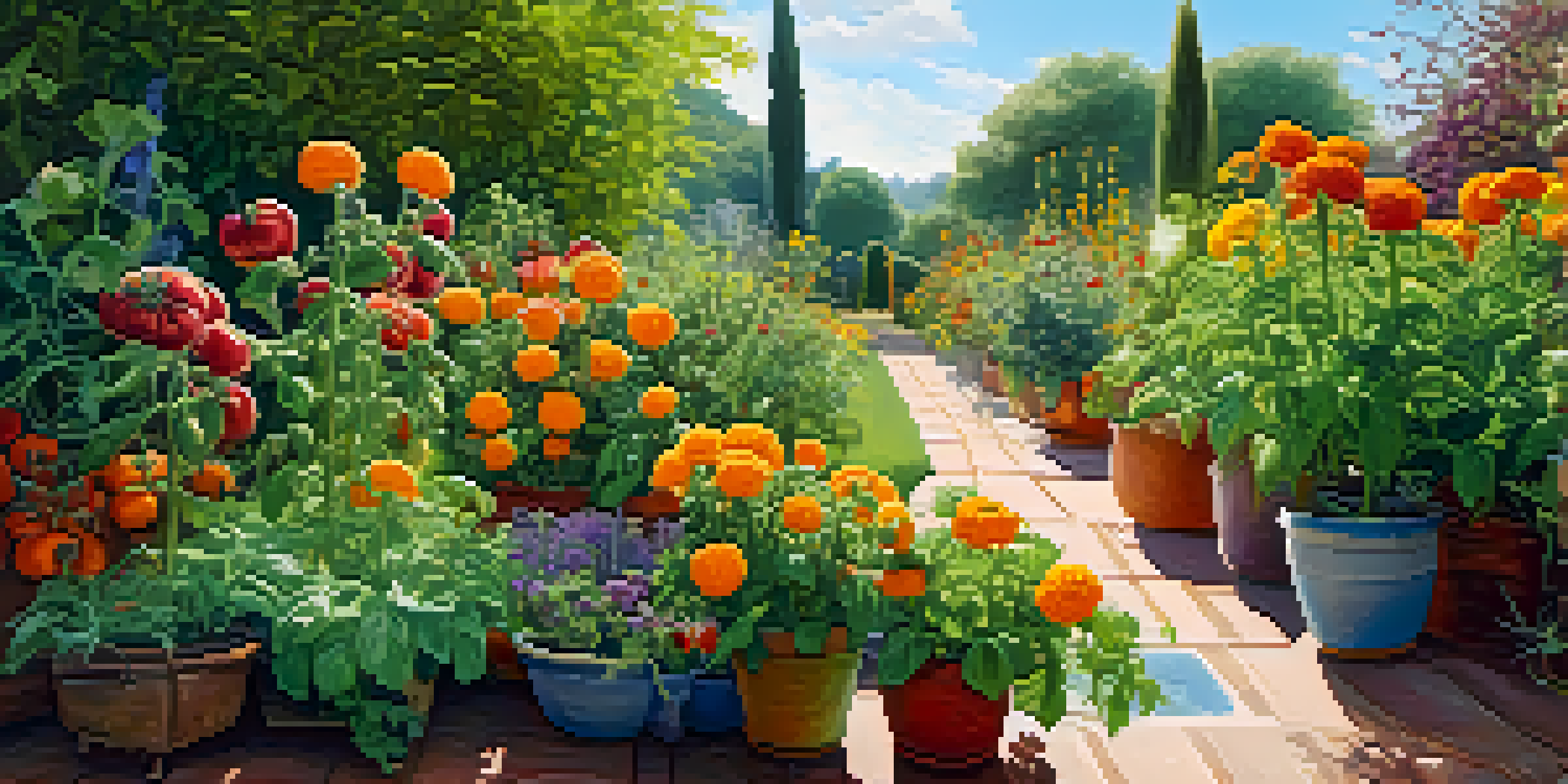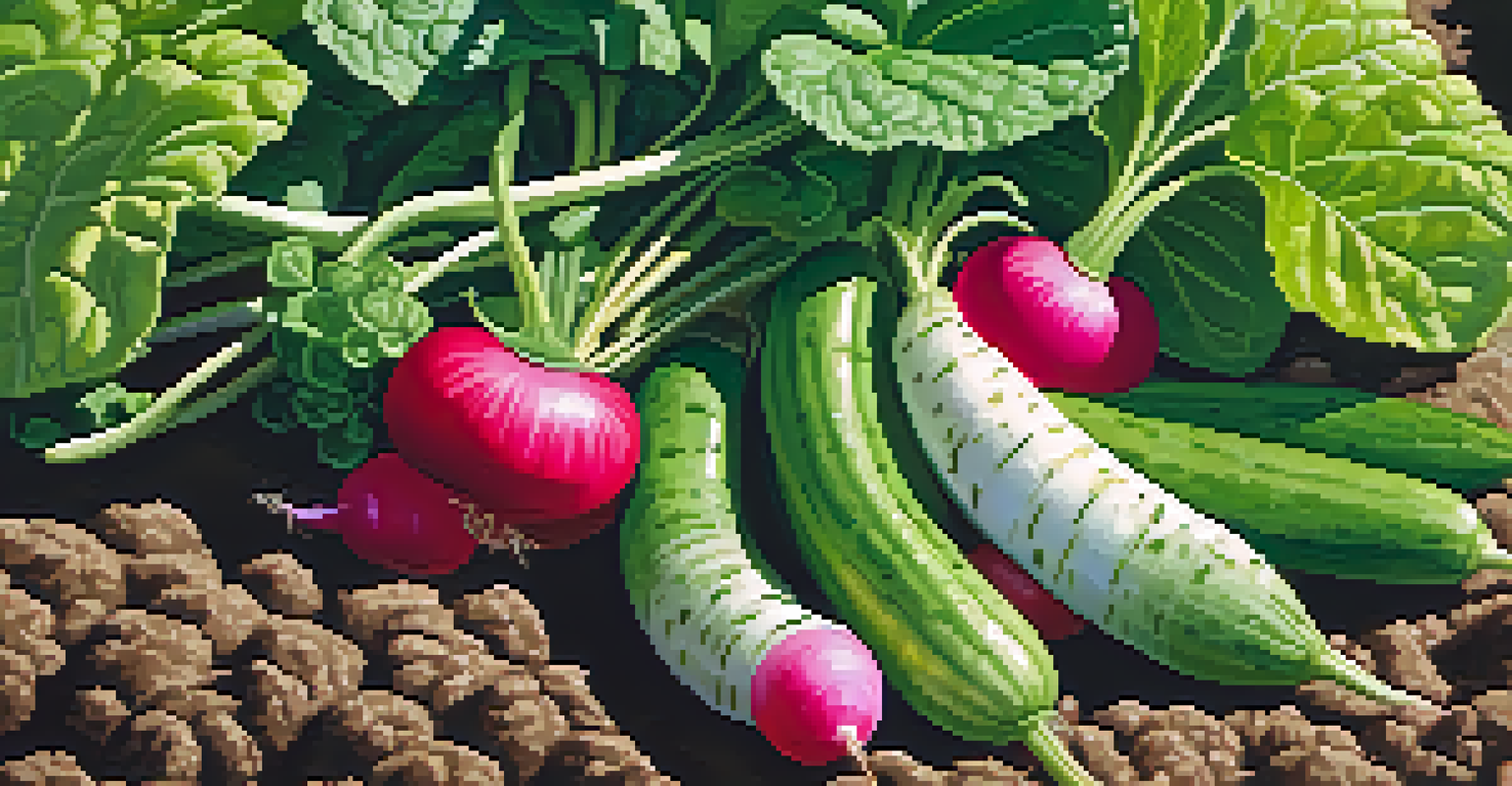Companion Planting: A Guide to Natural Pest Deterrents

What is Companion Planting and Why It Matters
Companion planting is the practice of growing different plants together for mutual benefits. This technique can improve growth, repel pests, and enhance flavor. By understanding which plants thrive together, gardeners can create a harmonious ecosystem in their gardens.
A garden is a friend you can visit any time.
One of the biggest benefits of companion planting is its ability to naturally deter pests. Instead of relying on chemical pesticides, which can harm beneficial insects, companion planting utilizes nature to keep pests at bay. This method not only protects your plants but also promotes a healthier garden environment.
For example, planting marigolds alongside vegetables can repel nematodes and aphids, acting as a natural pest control measure. By choosing the right combinations, gardeners can maximize their harvest while minimizing the need for artificial interventions.
The Science Behind Companion Planting
At the heart of companion planting lies a fascinating interplay of plants and their natural properties. Some plants release certain chemicals that can repel pests or attract beneficial insects. Understanding these relationships can help you make informed choices for your garden.

For instance, the strong scent of basil can confuse pests that might otherwise target tomatoes. This not only helps keep your tomatoes safe but also allows the basil to thrive. It’s a win-win situation that illustrates the beauty of nature’s design.
Companion Planting Boosts Growth
Growing compatible plants together enhances their growth and can improve flavor while naturally deterring pests.
Moreover, companion planting can improve soil health and biodiversity, making your garden more resilient against pests and diseases. When plants support each other, they create a thriving ecosystem that benefits not just them, but the entire garden.
Choosing the Right Companion Plants
Selecting the right companions for your plants is crucial for a successful garden. Certain combinations can enhance growth, while others may hinder it. Researching which plants grow well together can save you time and effort in the long run.
To plant a garden is to believe in tomorrow.
For example, beans fix nitrogen in the soil, making them excellent companions for corn, which benefits from the added nutrients. Meanwhile, planting carrots alongside onions can deter pests that target one or the other. Knowing these relationships can help you design a productive garden layout.
Remember, not all plants get along! Some can compete for space and nutrients, leading to poor growth. Always take the time to understand the compatibility of your chosen plants to ensure a flourishing garden.
Common Companion Planting Combinations
There are countless combinations of plants that work well together, but some are tried and tested favorites. For instance, growing tomatoes with basil not only enhances the flavor of both but also helps ward off pests. This classic duo is a staple in many home gardens.
Another popular pairing is cucumbers and radishes. The radishes can deter cucumber beetles while the cucumbers provide shade for the radishes, creating a mutually beneficial relationship. It’s like they’re looking out for each other, which is a beautiful aspect of companion planting.
Choosing the Right Combinations
Selecting appropriate companion plants is crucial, as some combinations can significantly improve garden productivity.
Additionally, planting nasturtiums near squash can attract aphids away from your squash plants, giving them a much-needed break. These combinations highlight how thoughtful planting can lead to a thriving garden ecosystem.
Using Flowers to Attract Beneficial Insects
Flowers are not just pretty additions to your garden; they can also play a crucial role in pest management. Many flowering plants attract beneficial insects like ladybugs and lacewings, which prey on harmful pests. Including these flowers can bolster your garden’s defenses.
For example, planting dill or fennel can attract parasitic wasps, which help control caterpillar populations. Similarly, sunflowers can attract a variety of beneficial insects, making them excellent companions for vegetables. It’s a natural way to bolster pest control without chemicals.
Moreover, these flowers can add beauty and diversity to your garden, creating a vibrant landscape. By embracing the natural relationships between plants and insects, you can cultivate a garden that thrives on balance and harmony.
Maintaining Your Companion Planting System
Once you’ve set up your companion planting system, maintaining it is essential for long-term success. Regular monitoring for pests and plant health will help you identify any issues early on. This proactive approach allows you to make adjustments as needed.
Additionally, rotating your crops each season can prevent soil depletion and reduce pest populations. By changing the location of your plants, you can disrupt the life cycles of pests and pathogens, promoting healthier growth.
Environmental Benefits Abound
Companion planting reduces chemical pesticide use, promoting a healthier ecosystem and improving soil health.
Finally, keep learning! Gardening is an ongoing journey, and observing how your plants interact can provide invaluable insights for future planting. Adapting your techniques based on experience will help you cultivate a thriving garden year after year.
The Environmental Benefits of Companion Planting
Companion planting isn’t just beneficial for your garden; it also has positive impacts on the environment. By reducing the reliance on chemical pesticides, you contribute to a healthier ecosystem that supports a diverse range of wildlife. This is particularly important in today’s world, where biodiversity is at risk.
Moreover, companion planting encourages soil health by promoting natural nutrient cycling. Plants that support each other can enrich the soil, leading to reduced erosion and improved water retention. This not only benefits your garden but also the surrounding environment.

By choosing to garden this way, you’re making a statement about sustainable practices. Every small step counts, and embracing companion planting is a powerful way to contribute to a healthier planet while enjoying the fruits of your labor.